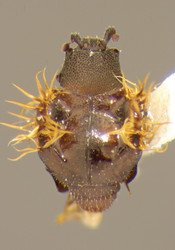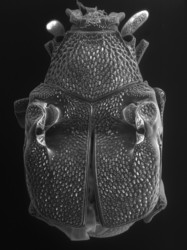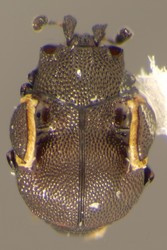Chlamydonia
Michael S. Caterino


This tree diagram shows the relationships between several groups of organisms.
The root of the current tree connects the organisms featured in this tree to their containing group and the rest of the Tree of Life. The basal branching point in the tree represents the ancestor of the other groups in the tree. This ancestor diversified over time into several descendent subgroups, which are represented as internal nodes and terminal taxa to the right.

You can click on the root to travel down the Tree of Life all the way to the root of all Life, and you can click on the names of descendent subgroups to travel up the Tree of Life all the way to individual species.
For more information on ToL tree formatting, please see Interpreting the Tree or Classification. To learn more about phylogenetic trees, please visit our Phylogenetic Biology pages.
close boxIntroduction
This genus was described recently, along with Kanakopsis and two species of Chlamydopsis, in a paper reporting Chlamydopsinae from New Caledonia for the first time (Caterino, 2006). Superficially its members appear similar to species in the genera Eucurtiopsis and Orectoscelis. However, they exhibit many structural differences that indicate that their similarities are probably convergent. Nearly all known specimens have been collected through the use of flight interception traps, so nothing is known about their habits or possible hosts.
Characteristics
The species of Chlamydonia are quite varied in appearance. Many species are strongly punctured and otherwise sculptured, while others are completely smooth. Some are very setose, while others are smooth. What they all share are series of frontal tubercles on the head, usually organized in two parallel series, paired pronotal tubercles (usually two pairs), and a doubled epipleural marginal stria, with the second appearing as an arc above the metafemoral apex (when the legs are held in the resting position.)
The trichomes generally form some kind of elongate disc, with setae along the rounded edge. The length and orientation of this disc vary greatly, as do the setae along its edge. In many species the setae are short and even, while in others they may be greatly elongated, projecting upward or outward from the body.
Discussion of Phylogenetic Relationships
The species level relationships within Chlamydonia were analyzed by Caterino (2006) in the paper featuring the species decriptions. The basal split in the genus is defined by the differing appearance of a median fovea on the inner surface of the trichome. While relationships depicted above are well supported for a few small groups of species, there is significant phylogenetic work still to be done in the genus. In particular, most species are known only from one sex (in most cases males), so it has not been possible to study genitalic characters in sufficient detail to include any in the analysis.
References
Caterino, M. S. 2006. Chlamydopsinae from New Caledonia. Memoirs of the Queensland Museum 52:27–64.
Information on the Internet
- Color images of all species. Supplement to descriptive paper, hosted by M. Caterino and the Santa Barbara Museum of Natural History.
Title Illustrations

| Scientific Name | Chlamydonia erectopilosa |
|---|---|
| Specimen Condition | Dead Specimen |
| Identified By | Michael S. Caterino |
| Collection | Museum National de Histoire Naturelle, Paris |
| Type | Holotype |
| Image Use |
 This media file is licensed under the Creative Commons Attribution-ShareAlike License - Version 3.0. This media file is licensed under the Creative Commons Attribution-ShareAlike License - Version 3.0.
|
| Copyright |
©
Michael S. Caterino

|
| Scientific Name | Chlamydonia sinuata |
|---|---|
| Specimen Condition | Dead Specimen |
| Identified By | Michael S. Caterino |
| Collection | Michael S. Caterino Collection |
| Type | Paratype |
| Image Use |
 This media file is licensed under the Creative Commons Attribution-ShareAlike License - Version 3.0. This media file is licensed under the Creative Commons Attribution-ShareAlike License - Version 3.0.
|
| Copyright |
©
Michael S. Caterino

|
| Scientific Name | Chlamydonia sol |
|---|---|
| Specimen Condition | Dead Specimen |
| Identified By | Michael S. Caterino |
| Type | Paratype |
| Image Use |
 This media file is licensed under the Creative Commons Attribution-ShareAlike License - Version 3.0. This media file is licensed under the Creative Commons Attribution-ShareAlike License - Version 3.0.
|
| Copyright |
©
Michael S. Caterino

|
About This Page
Michael S. Caterino

Santa Barbara Museum of Natural History, Santa Barbara, California, USA
Correspondence regarding this page should be directed to Michael S. Caterino at
mcaterino@sbnature2.org
Page copyright © 2007 Michael S. Caterino
 Page: Tree of Life
Chlamydonia .
Authored by
Michael S. Caterino.
The TEXT of this page is licensed under the
Creative Commons Attribution License - Version 3.0. Note that images and other media
featured on this page are each governed by their own license, and they may or may not be available
for reuse. Click on an image or a media link to access the media data window, which provides the
relevant licensing information. For the general terms and conditions of ToL material reuse and
redistribution, please see the Tree of Life Copyright
Policies.
Page: Tree of Life
Chlamydonia .
Authored by
Michael S. Caterino.
The TEXT of this page is licensed under the
Creative Commons Attribution License - Version 3.0. Note that images and other media
featured on this page are each governed by their own license, and they may or may not be available
for reuse. Click on an image or a media link to access the media data window, which provides the
relevant licensing information. For the general terms and conditions of ToL material reuse and
redistribution, please see the Tree of Life Copyright
Policies.
- First online 15 July 2007
- Content changed 15 July 2007
Citing this page:
Caterino, Michael S. 2007. Chlamydonia . Version 15 July 2007 (under construction). http://tolweb.org/Chlamydonia/107420/2007.07.15 in The Tree of Life Web Project, http://tolweb.org/











 Go to quick links
Go to quick search
Go to navigation for this section of the ToL site
Go to detailed links for the ToL site
Go to quick links
Go to quick search
Go to navigation for this section of the ToL site
Go to detailed links for the ToL site